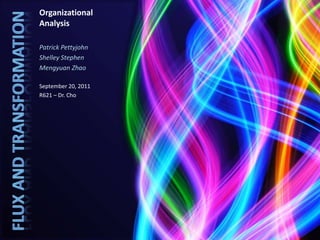Flux capacitors (2)
- 1. Organizational Analysis Patrick PettyjohnShelley StephenMengyuan ZhaoSeptember 20, 2011R621 â Dr. ChoFlux and transformation
- 2. Part 1 â Four Logics of ChangeTheoretical basis and paradigm characteristics
- 3. Autopoiesis TheoryDefined: Reveals the relationship between systems and their environments.
- 4. Autopoiesis TheoryDefined: Reveals the relationship between systems and their environments.Borders BookstoresStarted as homey, but large, bookstore in Ann Arbor, MI, staffed by book lovers.Hired non-book people and narrowing selection without recognizing corporate identity change.
- 5. Chaos and Complexity TheoryDefined: How ordered patterns of activity can emerge from spontaneous self-organization
- 6. Chaos and Complexity TheoryDefined: How ordered patterns of activity can emerge from spontaneous self-organizationBorders BookstoresAttractor of e-books readers ignoredStayed with more dominant attractors - established mindsets and power basesTried surviving as discrete corporate entity
- 7. Mutual Causality TheoryDefined: Change is enfolded in the strains and tensions found in circular relations.
- 8. Mutual Causality TheoryDefined: Change is enfolded in the strains and tensions found in circular relations.Borders BookstoresGood results with continuous expansion through the early 2000âs reinforced positive feedback loop.Achieved a level of growth that was unsustainable.
- 9. Dialectical Change TheoryDefined: Change is the product of tensions between opposites.
- 10. Dialectical Change TheoryDefined: Change is the product of tensions between opposites.Borders BookstoresOpened a website for 2 years, sold it to Amazon, did not open another for 10 years.Decision to not be an internet player embraced a polarized view rather than finding a way to live in internet world.
Editor's Notes
- #5: Lost its identity - started as a homey, but large, bookstore in Ann Arbor, MI run by book lovers.Began hiring non-book people and narrowing selection gradually. Corporate identity still thought it was maintaining the bookish façade. True 'bookies' realized the change was happening.http://articles.cnn.com/2011-09-12/us/first.borders.bookstore.closing_1_borders-rewards-bookstore-woolworth?_s=PM:US'The death and life of great American bookstore'September 12, 2011 By Todd Leopold, CNN
- #7: Shows resistance to change to new book formats such as e-books - being led by a more dominant attractor - established mind sets and power bases, tried to survive as a discrete corporate identity rather than adapt. http://articles.cnn.com/2011-09-12/us/first.borders.bookstore.closing_1_borders-rewards-bookstore-woolworth?_s=PM:US'The death and life of great American bookstore'September 12, 2011 By Todd Leopold, CNN
- #9: http://articles.cnn.com/2011-09-12/us/first.borders.bookstore.closing_1_borders-rewards-bookstore-woolworth?_s=PM:US'The death and life of great American bookstore'September 12, 2011 By Todd Leopold, CNN
- #11: Not an internet player About 10 years ago, Borders handed its internet operations to Amazon and did not relaunch it's own website until 2008. One Chapter Closes... --- Passing of Borders Is Serious Drama For Readers, Authors and Publishers By Mike Spector and Jeffrey A. Trachtenberg 918 words 20 July 2011Embraces one pole completely - no prescence - rather than finding middle ground.










